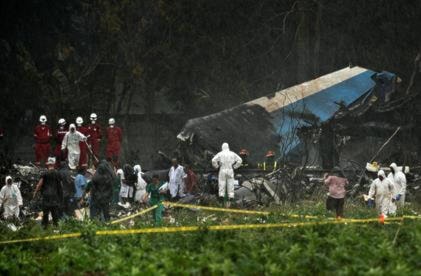The only three survivors of a plane crash in Cuba remained in grave condition Saturday as investigators tried to determine why an aging Boeing 737 carrying 110 people went down and erupted in flames shortly after takeoff in Havana.
It was Cuba’s worst aviation disaster in three decades and its third major air accident since 2010. Skies were overcast and rainy at the airport at the time of Friday’s disaster and Cuban state television said the 39-year-old jet veered sharply to the right after departing on a domestic flight to the eastern city of Holguin.
“The only thing we heard, when we were checking in, an explosion, the lights went out in the airport and we looked out and saw black smoke rising and they told us a plane had crashed,” Argentine tourist Brian Horanbuena told The Associated Press at the airport.
Cuban President Miguel Diaz-Canel said a special commission had been formed to find the cause of the crash. The plane had 104 mainly Cuban passengers and six crew members.
“Things have been organized, the fire has been put out, and the remains are being identified,” he said.
State airline Cubana, which operated the flight, has had a generally good safety record but is notorious for delays and cancellations and has taken many of its planes out of service because of maintenance problems in recent months, prompting it to hire charter aircraft from other companies.
Mexican officials said the Boeing 737-201 was built in 1979 and rented by Cubana from Aerolineas Damojh, a small charter company that also goes by the name Global Air.
Aviation authorities in Guyana last year stopped the same aircraft from conducting charter flights because of serious safety concerns, including fears about excessive baggage overloading and other issues.
Cubana Flight 972 went down just after noon a short distance from the end of the runway at Jose Marti International Airport. Firefighters rushed to extinguish the flames that engulfed the debris left where the jet hit the ground in a cassava field.
Four crash survivors were taken to a Havana hospital, and three remained alive as of late Friday. State media reports stopped short of openly declaring that the rest on board were dead, but there was no word of other survivors by Friday night.
Relatives of those aboard were ushered into a private area at the terminal to await word on their loved ones.
“My daughter is 24, my God, she’s only 24!” cried Beatriz Pantoja, whose daughter Leticia was on the plane.
A statement from Mexico’s Transportation Department identified the pilot and co-pilot as Capt. Jorge Luis Nunez Santos and first officer Miguel Angel Arreola Ramirez. It said the flight attendants were Maria Daniela Rios, Abigail Hernandez Garcia and Beatriz Limon. Global Air said maintenance worker Marco Antonio Lopez Perez was also aboard.
Outside the company’s Mexico City offices, former Global Air flight attendant Ana Marlen Covarrubias said she had worked for the company for over seven years and knows nearly all the crew members.
“I don’t have the words. I’m very sad. We’re in mourning,” she said in tears. “It was something really, really, really terrible; a tragedy for us.”
In addition to the Mexican crew, Cuban Communist Party newspaper Granma reported that the passengers were mostly Cubans plus five foreigners from countries it did not identify. Argentina’s Foreign Ministry said two of its citizens had died in the crash.
In November 2010 a Global Air flight originating in Mexico City made an emergency landing in Puerto Vallarta because its front landing gear did not deploy. The fire was quickly extinguished, and none of the 104 people aboard were injured. That plane was a 737 first put into service in 1975.
Mexican aviation authorities said a team of experts would fly to Cuba on Saturday to take part in the investigation.
First Vice-President Salvador Valdes Mesa had met with Cubana officials on Thursday to discuss improvements to its service. The airline blames its spotty record on a lack of parts and airplanes because of the U.S. trade embargo against the communist-run country.
Last year a Cuban military plane crashed into a hillside in the western province of Artemisa, killing eight soldiers. In 2010, an AeroCaribbean flight from Santiago to Havana went down in bad weather, killing all 68 people on board, including 28 foreigners, in what was the country’s worst air disaster in more than two decades.
The last deadly accident involving a Cubana-operated plane was in 1989, when a charter flight from Havana to Milan, Italy, crashed shortly after takeoff, killing all 126 people on board and at least two dozen on the ground.
Associated Press writer Amy Guthrie contributed to this report from Mexico City.
Andrea Rodriguez And Michael Weissenstein, The Associated Press
